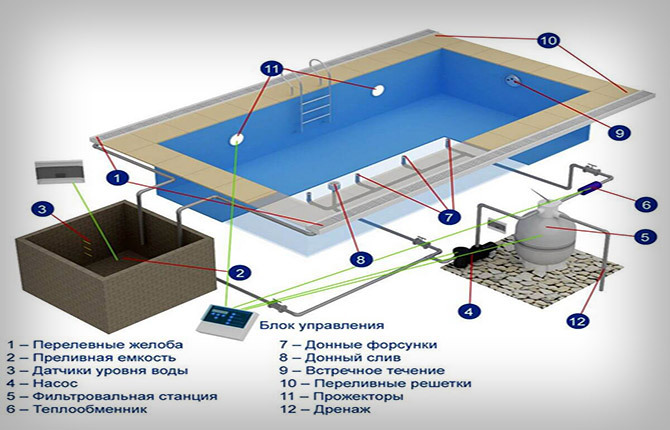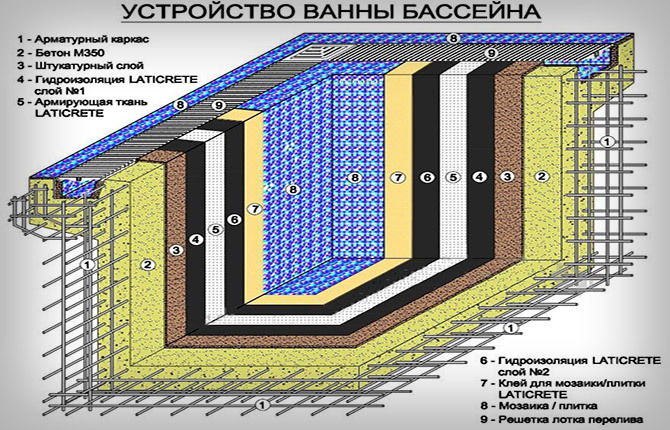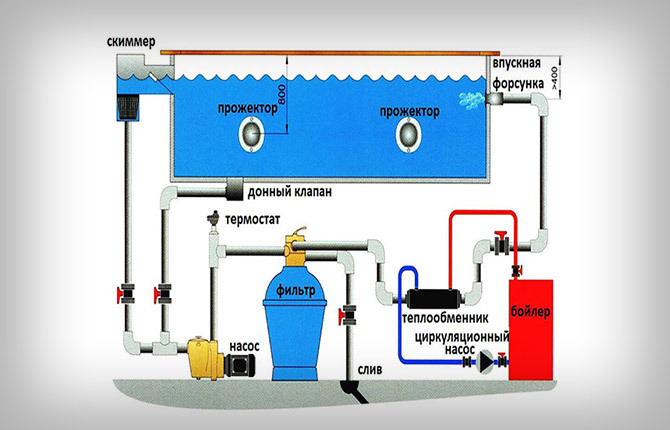The reactivation of the pool is one of the stages of preparing an open artificial reservoir for use in the new season. The complexity of the maintenance of the structure, the total resource of the pool, the costs of preparing for its operation depend on how it will be carried out.

The content of the article:
-
Pool launch steps: step by step instructions
- Initial preparation for re-preservation
- pool cleaning
- Equipment installation
- Initial start of water
- What else is worth knowing about the initial start-up of water in the pool
Pool launch steps: step by step instructions
The reactivation of the pool after the winter is its preparation for further operation in the summer. It is necessary to carry out the procedure long before this, even if it is not planned to use the design yet. Especially if conservation was carried out in the fall, and water remained in the bowl.
To determine the time of the procedure, they are guided by:
- Ice. If it melted on its own, and at night an ice crust does not form on the surface, you can proceed to re-preservation.
- Air temperature. It is necessary that during the day it does not fall below +10 degrees.
Preparation procedure basin for further use consists of several stages and requires certain tools:
- water vacuum cleaner;
- tools for cleaning the bowl (scrapers, brushes);
- chemical cleaning and disinfecting reagents (algicides, coagulants, acidity regulators);
- personal protective equipment and clothing (gloves, respirator, boots);
- pipes, lamps, other removable equipment.
Initial preparation for re-preservation
Before putting the pool into operation after winter, it is necessary to prepare it:
- Inspection of the bowl and existing communications for damage. If they have been identified, they must be eliminated.
- Removable equipment that was dismantled before the conservation of the pool is checked.
- Preparation of devices, mechanisms that are used for maintenance in the summer season. This includes testers for determining the pH level of water, sponges, nets for cleaning.
- Preparation of chemical reagents (coagulants, algicides). It is recommended to buy new preparations every season. Even if their shelf life has not yet expired, they may have suffered damage during storage.
At the preparatory stage, the protective structure is removed. When conserving an outdoor pool, awnings or other protective structures are used. Their task is to prevent contamination of the bowl due to the ingress of snow, melt water, dust or other debris. When removing such a device, it is necessary to ensure that the debris that is on its surface does not get inside. This will make the procedure easier.
pool cleaning
If water was left inside the bowl of an outdoor pool for the winter, it must be drained, after removing large debris from its surface. A submersible pump is used for draining. It can be drainage or filtration. Next, pipe plugs, hydraulic lifters are removed. If there is liquid left inside that cannot be pumped out, a rag is used.
Special tools are used to clean the bowl. They not only clean its surface well, but also form a protective film on the surface. It prevents the formation of deposits. For metal parts, other substances are used that will not damage chrome or stainless steel. To apply an antifungal agent, take a brush or spray.
At this stage, the surface of the bowl is checked for damage. If they are, they are repaired. After that, they begin to install removable structures (steps, slides, lighting fixtures).

Healthy: Organization of pool ventilation.
Equipment installation
At the next stage of the reactivation of the pool, the installation of equipment (counterflows, filters, heaters, disinfectors) is carried out, which was dismantled in the fall. It is necessary to remove it before wintering to protect parts from damage when water freezes.
Before installing the equipment, the cartridges and filter mass are replaced. When assembling them, it is necessary to check the integrity of all connections, gaskets, fixing nuts. If a thermostat is used, it must be adjusted. The integrity and serviceability of the electrical wiring is checked. Finally, the dosing device is calibrated.
Initial start of water
The next stage of re-preservation is filling the bowl with water. To do this, fill the pump with liquid. In addition, water is drained from the pipes. She can be dirty here.
To drive the skimmers and adjust the circulation system, the bowl is filled to the maximum level. If the design has an overflow device, the liquid is drawn up to the middle of the intermediate tank. At the same time, all pipes are inspected for the integrity of their surfaces. If a leak is found, the damaged area is repaired or replaced with a new one. At the stage of re-preservation, the water treatment system is not used. This will protect it from clogging. The repeated process of filling the pool is carried out already with its use.

What else is worth knowing about the initial start-up of water in the pool
The process of starting water during the reactivation of the pool involves its purification. At the initial stage, mechanical cleaning is carried out. If you skip this procedure when depreserving, debris can get into the filter. This may cause it to become clogged or damaged. A net is used to remove debris. To remove the sediment at the bottom, you will need a special vacuum cleaner.
Before turning on the filtration system, preliminary water treatment is carried out. This adds coagulant. This is a substance capable of trapping and binding fine particles into flakes. Further, such particles are caught with a net or a vacuum cleaner. This avoids clogging of the filter and makes the depreservation procedure faster. The amount of coagulant is calculated based on the volume of water poured into the bowl and the manufacturer's recommendations.
For prevention, during re-preservation, an algicide preparation is added to the water, which can fight the development of algae.
Carrying out the re-preservation of the pool, check:
- pH level of water;
- chlorine concentration.
These components are interdependent. If the pH is too high, then the effectiveness of chlorine application will be small or there will be no effect. In this case, even a small amount of added chlorine will lead to the formation of a pungent odor.
Testers are used to check the pH level and the amount of chlorine. The easiest option is a double container with a scale. Water is collected here, to which reagents are added. Based on the shade that the liquid acquires and the designations on the scale, the parameters of the amount of chlorine and the pH level are determined.
If the length of the pool is 5 meters or more, the water must be sampled several times, taking liquid from different places. This will give you more accurate results..
To adjust the pH level, use means that are called pH plus (to increase acidity) or pH minus (to decrease the indicator).
The chlorine concentration is also measured. The reagent can be produced in the form of a soluble powder or tablets. You can choose any available tool.
Only after the completion of the above stages of reactivation, the pool is considered prepared and can be launched. This process includes turning on the filter and circulation unit. If there is heating equipment, it is configured. Separately, during re-preservation, it is worth checking the operation of lighting, the system for dosing and supplying reagents, and sensors that control water parameters.

It is considered that the reactivation was successful and the pool can be used if:
- the water is completely transparent;
- the surface of the bowl is cleared of sediment;
- water has a comfortable temperature for use;
- indicators of chemical parameters correspond to the norm;
- all equipment is working properly;
- there are no leaks in the system.
Depreservation seems to be a rather complicated procedure. But, if you follow the described instructions, then everyone can cope with this task. How do you prepare the pool for the summer season? Share your experience in the comments.
Healthy: How to make a pool with your own hands.
Don't forget to bookmark the article and share the information with your friends.
